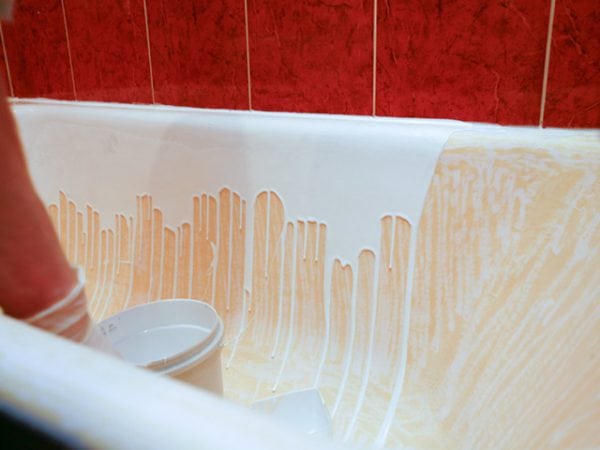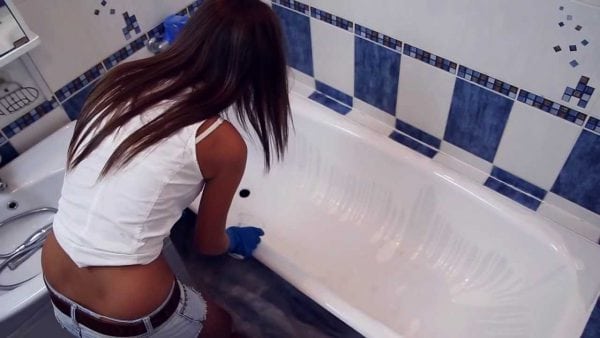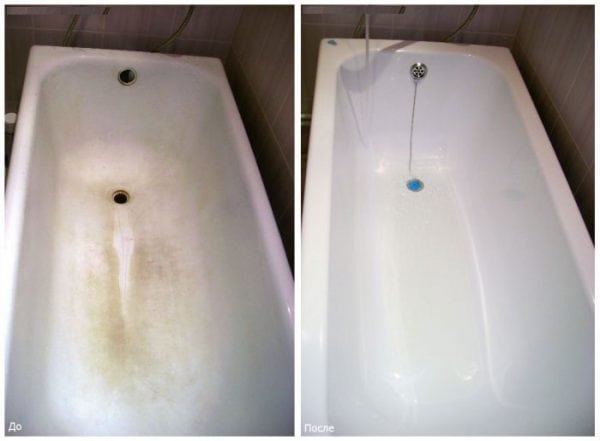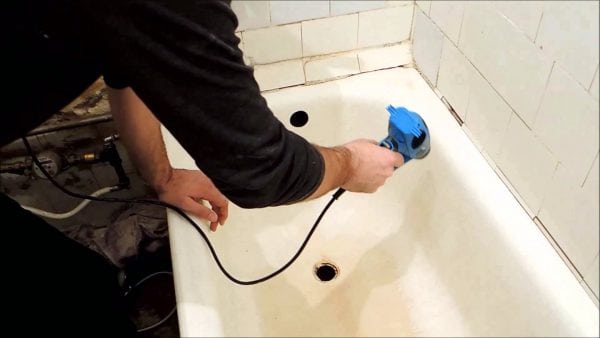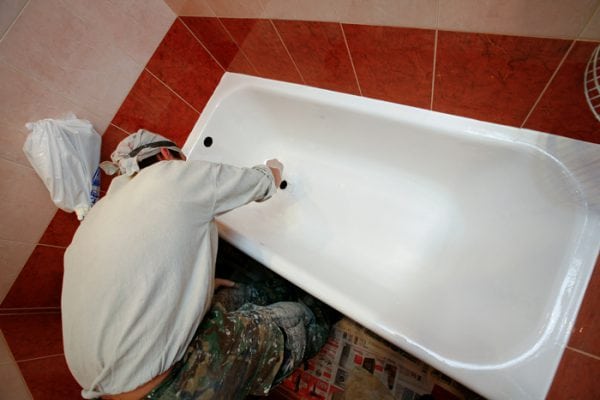The idea not to change the old plumbing covered with rusty spots, but to cover the bathtub with acrylics arises among many craftsmen during home repairs. But is acrylic really good for restoring an old bath, or is it better to use another coating, for example, traditional enamel, for restoration? Moreover, the price of acrylic composition is quite high.
- What is acrylic for plumbing restoration
- Cure time
- The duration of the activity of the mixed composition
- Lifetime
- Coating method
- Smell
- Price
- Consumption
- Advantages and disadvantages of acrylic coating
- Materials for independent restoration work
- Technology of work
- Further care
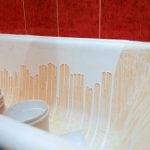
What is acrylic for plumbing restoration
Liquid acrylic is a two-component mixture consisting of an acrylic base and a hardener. The components are mixed before the restoration.
When choosing an acrylic composition, you should pay attention to the following characteristics in order to acquire a truly suitable material.
Cure time
The faster the solution solidifies on the surface of the product, the lower the coating strength. The process of complete hardening should take about 2-4 days. Of course, this causes some inconvenience due to the inability to use the bath, but this time is necessary for the complete polymerization of the material and to achieve its sufficient strength.
The duration of the activity of the mixed composition
To get a smooth smooth surface of the bathroom, the restoration of the product cannot be interrupted, and the solution is made immediately in the quantity necessary for the work. But the mixture begins polymerization not only on the walls of the bath, but also in the tank, which leads to a deterioration in its fluidity, to the appearance of stains and spots on the surface of the product. The optimal period of activity of the solution is considered to be 60-70 minutes (approximately the same time is required to cover the old bathtub with an acrylic composition).
to contents ↑Lifetime
Typically, 20 years is indicated, but with appropriate care of the product may be longer. Be sure to take into account the ratio of the service life and the polymerization time of the composition with acrylic. If it is indicated that the bath can be used only a few hours after acrylic coating, then the service life of the material is greatly overestimated.
to contents ↑Coating method
Acrylic for restoration of an old bath should be applied only by bulk method. If other ways of applying the material are indicated on the package, then it is not recommended to purchase it, most likely, it is less durable Stakril.
Smell
Acrylic is odorless, so do not buy sharply smelling products.
Price
This is not a primary indicator. The price varies taking into account additional components that give strength to the composition of the components and taking into account the name of the manufacturer. On average, the price is from 1,500 rubles for a capacity of 3-3.5 kg.
Consumption
Consumption of material for restoration depends on the condition of the old bath surface. But for a standard bathtub with a length of 150-170 cm, 2-2.5 packages are needed. Compared to acquiring a new bathtub, acrylic restoration is a more affordable option.
to contents ↑Advantages and disadvantages of acrylic coating
Some masters still doubt whether to give preference to acrylic or to restore the old bath using traditional enamels.Restoration of a product using one or another material has its pros and cons.
Advantages of acrylic restoration:
- Easy to apply. There is no need for special painting tools, you can carry out restoration work yourself.
- The ability to use a bulk method to obtain a smooth coating without streaks and streaks.
- High adhesion to the surface of the bath.
- Long product life after recovery (more than 20 years).
- High strength.
- Hygiene (acrylic surface does not trap dirt and makes it easier to care for the sanitary ware).
- Possibility of tinting (a bath during restoration can be made of any color).
- Increased thermal conductivity (acrylic retains heat well, and thanks to this property, the water poured into the bath will cool longer).
- It does not have a specific smell, which persists for a long time after restoration.
Cons of acrylic as a material for coating the bath:
- Low resistance to chemical and abrasive household chemicals. After restoration, the bath can only be washed with gentle detergents.
- Duration of acrylic polymerization. Due to the long hardening period after application of the composition, the product cannot be used for several days. In order not to experience any inconvenience, you can install an acrylic liner. Restoration with the insert takes place during the day, but the price for restoring the product will be higher.
- The high price of the material for restoration. This is a conditional flaw. It is enough to take into account the price ratio of the new bath and the service life of the coating, and the benefit will become obvious. Even installing a liner, the price of which will be approximately 30% of the price of a new bath, will be profitable.
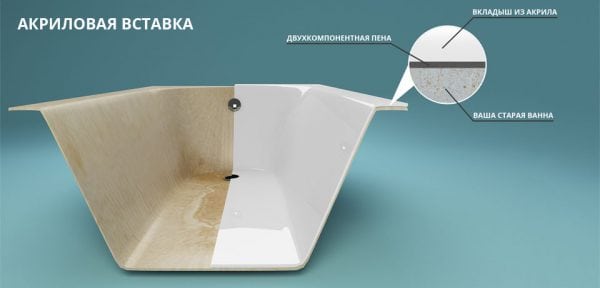
For those for whom the inconvenience associated with the restoration of the old bathtub with liquid acrylic outweighs all the advantages of the material, it is recommended to insert a polymer liner. Like any restoration method, inserting an acrylic liner has its pros and cons. The benefits include:
- The ability to withstand large mechanical loads.
- Resistant to damage. The liner has a higher density compared to the bulk coating, and it is almost impossible to damage the insert.
- Quick installation. If you have a small skill in carrying out such work, even a home craftsman can make an insert insert.
By cons include:
- An acrylic liner can be made only by industrial polymerization of the material, and if the manufacturing technology is violated, the polymer properties may be impaired. It is impossible to visually identify the marriage of the product - errors will be detected only during operation after installation.
- Installation difficulty. The insertion process has many important nuances, and if you neglect them, the service life of the product may be reduced. For example, if the gap between the bathtub and the inserted form of acrylic is not very well filled with polyurethane, then cracks may appear on the material during operation.
to contents ↑Before you install the tab yourself, you need to think carefully: the installation price is not very high, and violations during installation can degrade the properties of the polymer. Perhaps it is better to pay professional craftsmen for the work than to change the liner soon. In the second case, you have to pay a big price.
Materials for independent restoration work
If not everyone can install the tabs, then any master can perform the coating using the bulk method. To work, you will need:
- rubber spatula;
- rags and special solvent;
- capacity with a thin nozzle;
- polyethylene and masking tape;
- gas key;
- sandpaper to remove the old layer from the product. To speed up the cleaning process, you can use a grinding machine with the appropriate nozzle.
Having prepared everything you need, you can begin the restoration.
to contents ↑Technology of work
Before proceeding with restoration using the bulk method, it is necessary to remove the old, rust-stained coating. You can use a grinding machine - it removes old enamel well.This method is the fastest when removing the coating, but during it a lot of dust appears, and it is recommended to work in a respirator.
Next we perform the following steps:
- After removing the enamel that has expired, it is sanded with sandpaper, large cracks are sealed with a special sealant.
- The polished product is degreased with a special solvent (any dishwashing detergent may be used).
- After drying the surface, you need to close the tap with polyethylene, tape over the walls adjoining the bathroom with tape and remove the siphon from the plumbing. In place of the siphon, put any unnecessary capacity.
Upon completion of the preparation, you can proceed to the restoration of the bath. For this:
- Mix acrylic and hardener until smooth, as indicated in the instructions. If you need tinting, then add the color of the desired color.
- Pour the finished mixture into a container with a thin nozzle.
After this, using the bulk method, you can apply the coating:
- The filling starts from the upper edges around the perimeter, making sure that the dye flows off uniformly in streaks, forming an even layer.
- If streaks or spots have formed during the filling process, you do not need to touch them - they themselves drain to the bottom of the bathtub.
- At the bottom of the bath, the top dye is neatly leveled with a rubber spatula, and its excess is removed into the drain hole.
After this, the restoration can be considered completed, and the bath is left to dry.
to contents ↑Further care
Acrylic coating has excellent dirt-repellent properties and does not require special care, the use of any special cleaning agents or tools.
When caring for the surface of the bath, you only need to use mild household cleaning products and carry out the first cleaning no earlier than 2 weeks after applying the composition.
Bulk application of acrylic is one of the easiest and most durable ways to give an old, cracked and stained bathtub a beautiful, stylish look.

